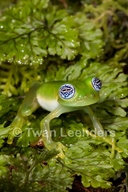|
Sachatamia ilex (Savage, 1967)
Ghost Glass Frog, Limon Giant Glass Frog, Holly’s Glassfrog, Rana de Cristal de Holly, Rana de Cristal Fantasma. | family: Centrolenidae subfamily: Centroleninae genus: Sachatamia |
 © 2009 Twan Leenders (1 of 36) |
|
|
|
Description Sachatamia ilex has a deep leaf green body, with a light green or white throat and belly, and a distinct white lip stripe (Leenders 2001; Savage 2002). Occasionally, scattered white dots are present on the dorsum. This frog also has yellowish hands and feet (Leenders 2001). The bones are dark green, a characteristic shared with other centrolenid frogs and one genus of hylid frogs, Trachycephalus (treated under the name Phrynohyas in Savage 2002). Sachatamia ilex has a white, parietal peritoneal sheath covering its internal organs (Leenders 2001). The digestive tract itself is unpigmented (Savage 2002). The eyes are silver with black reticulations, and are positioned on top of the large semicircular head so that the eyes point directly forward (Leenders 2001). Nuptial pads are white (Savage 2002). Distribution and Habitat Country distribution from AmphibiaWeb's database: Colombia, Costa Rica, Ecuador, Nicaragua, Panama
Life History, Abundance, Activity, and Special Behaviors It is able to vary the intensity of its green coloration to match the substrate on which it is resting (Leenders 2001). Males call from the upper side of leaves, usually with the head facing the tip of the leaf (Cisneros-Heredia and McDiarmid 2007). The call consists of a single high-pitched "click", repeated after intervals of several minutes (Savage 2002). Females deposit black eggs on upper leaf surfaces overhanging a stream (Savage 2002). Trends and Threats Possible reasons for amphibian decline General habitat alteration and loss Comments A Spanish-language species account can be found at the website of Instituto Nacional de Biodiversidad (INBio).
References
Cisneros-Heredia, D. F., and McDiarmid, R. W. (2007). ''Revision of the characters of Centrolenidae (Amphibia: Anura: Athesphatanura), with comments on its taxonomy and the description of new taxa of glassfrogs.'' Zootaxa, 1572, 1-82. Guyer, C., and Donnelly, M. A. (2005). Amphibians and Reptiles of La Selva, Costa Rica and the Caribbean Slope: A Comprehensive Guide. University of California Press, Berkeley. IUCN, Conservation International, and NatureServe. 2006. Global Amphibian Assessment. www.globalamphibians.org. Accessed on 21 July 2007. Leenders, T. (2001). A Guide to Amphibians And Reptiles of Costa Rica. Zona Tropical, Miami. Savage, J. M. (2002). The Amphibians and Reptiles of Costa Rica:a herpetofauna between two continents, between two seas. University of Chicago Press, Chicago, Illinois, USA and London. Originally submitted by: Rupi Mudan (first posted 2005-11-01) Description by: Ann T. Chang (updated 2021-05-22)
Distribution by: Ann T. Chang (updated 2021-05-22)
Life history by: Ann T. Chang (updated 2021-05-22)
Comments by: Ann T. Chang (updated 2021-05-22)
Edited by: Kevin Gin, Ann T. Chang (2021-05-22) Species Account Citation: AmphibiaWeb 2021 Sachatamia ilex: Ghost Glass Frog <https://amphibiaweb.org/species/1729> University of California, Berkeley, CA, USA. Accessed Nov 4, 2024.
Feedback or comments about this page.
Citation: AmphibiaWeb. 2024. <https://amphibiaweb.org> University of California, Berkeley, CA, USA. Accessed 4 Nov 2024. AmphibiaWeb's policy on data use. |




 Map of Life
Map of Life